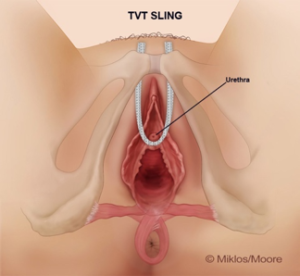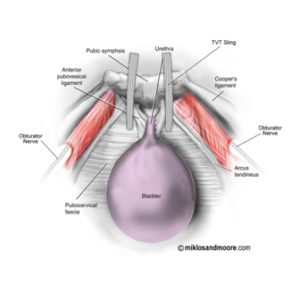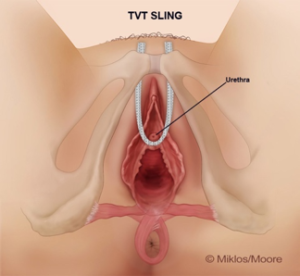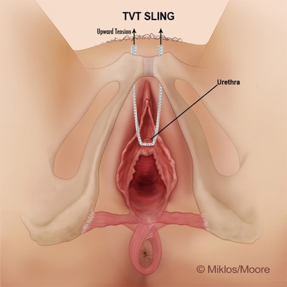TVT SLING COMPLICATIONS AND MESH REMOVAL
TVT slings ie tension free vaginal tape slings is a type of transvaginal mesh that may result in mesh pain, extrusion, erosion or infection and require surgery for mesh removal.
TVT slings also known as synthetic mesh retropubic slings is made from polypropylene synthetic mesh and was first introduced into Europe in 1995 for the treatment of stress urine incontinence. The sling is a synthetic piece of mesh which is placed under the urethra and exits the body behind the pubic bone and scars into place without the need for sutures, anchors or glue.
In 1998, a group of surgeons including Dr John Miklos from the US were trained in Uppsala Sweden on the surgical technique and application of the sling for female patients. The cure rates were found to be equally effective as other “gold standard anti-incontinence procedure such as Burch, tissue slings, Marshall Marchetti Krantz which already being performed in the U.S. for decades. The new TVT sling operation seemed to easier to perform, create less post-operative pain for the patient, less blood loss, less chance of urine retention, a quicker return to everyday activities and smaller or fewer incisions than those surgeries mentioned above. Within 5 years the TVT sling took the world by storm and basically became the new “gold standard”. The surgeons really felt they had found the “holy grail” of anti-incontinence surgical procedure for stress urinary incontinence.
The TVT has remained the “go to operation” or procedure of choice throughout the U.S. as well as many other parts of the world since its induction. The TVT sling operation has become the most investigated and studied anti leakage operation in the world over the last 100 years. Unfortunately, even studies don’t cover all the benefits, complications or risks of a surgical technique as most studies tend to focus initially on immediate post-operative cure rates as well as intra operative and immediate post-operative complications. Initial studies investigated the number one post-operative complication which was vaginal mesh extrusion or exposure through the vaginal epithelium or skin of the vagina, urine retention, urgency, frequency, and recurrent urinary tract infections i.e. UTI. Few studies ever focused on the more devastating and debilitating long term complications including: mesh erosion into the urethra, mesh erosion into the bladder, vaginal pain, dyspareunia or painful intercourse, levator myalgia and lower abdominal pain. The TVT sling remains an excellent choice for stress urinary incontinence, however over time surgeons such as Drs’ Miklos & Moore have realized the TVT sling is not without long term life altering complications. Failure to recognize these complications can leave patients frustrated, angry and without hope as well as destroy lives, relationships and marriages. Some of the complications associated with the TVT sling surgery include:
Urine retention – or the inability to adequately empty the bladder is a potential complication of all anti leakage surgeries. Usually this condition is diagnosed in the first 14 days of the surgery but Dr Miklos & Moore have seen patients come back months and years after their TVT surgery with urine retention and this was after the patient initially was voiding and emptying her bladder adequately. It appears that the sling can continue to contract over months and years due to a long term inflammatory reaction which initiates and perpetuates scarring around the synthetic mesh fibers of which the sling is composed.
Urgency & Frequency – of urination can occur after all anti incontinence procedures and usually these symptoms will go away over time. Conventional wisdom suggests that the urgency and frequency occurs due to the slightly obstructive effect causes by the anti-leakage surgery. It is almost impossible to perform and anti-leakage operation without creating some type of obstructive effect to the urethra. Usually the urgency and frequency will be transitory or temporary and dissipate over a period of a few days or weeks. Sometimes the condition requires using an anticholinergic medication (i.e. anti bladder spasm medication) to sooth the bladder muscle spasms. Finally, if the condition is so severe and the urgency and frequency do not go away the sling may require removal.
Recurrent Urinary Tract Infections – may or may not be related to the sling placement. Dr Miklos & Moore have had patients who never had a urinary tract infection until their TVT sling was placed and have had other patients who claim their UTI’s went away after placing a TVT sling. Recurring UTI’s can be a debilitating condition making a woman’s life miserable and unbearable. The problem is no surgeon can definitively say that it is the synthetic mesh or the change of anatomy which might be causing the problem. If it were the mesh then every patient who complains of recurrent UTI’s after a TVT placement could undoubtedly be treated by removing the mesh and this is simply not the case. Of course, the only way to determine whether the sling removal will help the situation is to remove the sling and Drs’ Miklos and Moore do just that when a person’s primary complaint is recurrent UTI and they want the sling removed. Drs Miklos and Moore will evaluate whether the sling has eroded into the urethra or bladder prior to surgery (as an erosion into these structures do increase the risks of UTI’s) and discuss removing the whole sling even from the inside of the bladder and urethra if needed.
Bladder or Urethra TVT Erosion – can occur over time and if the mesh is found in the urethra or bladder many patients will suffer from pain with intercourse (aka dyspareunia), blood in the urine (hematuria), pain with urination (dysuria), vaginal pain, pelvic pain and recurrent UTIs. Often these conditions will go undiagnosed for months if not years as the average gynecologist and urologist do not realize the mesh can erode into these structures. After months and sometime years of complaining and being told it is not their TVT mesh the patients will often be referred to a urogynecologist or urologists where the diagnosis is made usually on cystoscopy. Most urologists will attempt to cut and then burn the edges of the mesh out of the wall of these structures. Often the mesh edges will retract but are still embedded within the wall of the urethra and/or bladder muscle and through continuous scarring and contracting the patient will continue to have urgency, frequency, and pain with urination and intercourse. Drs Miklos and Moore can completely remove the mesh from a patient’s bladder and or urethra through minimally invasive surgical techniques i.e. small incisions.





